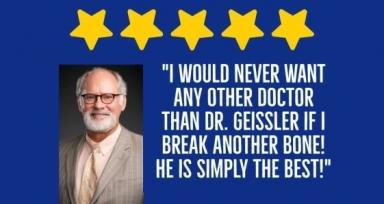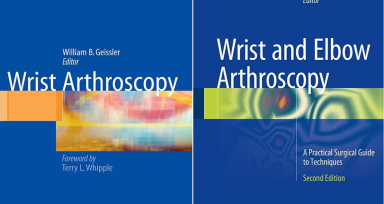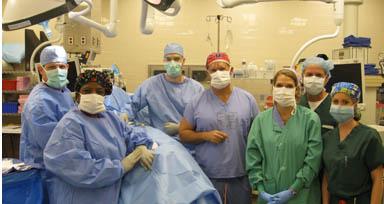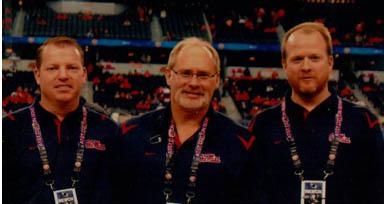June 11, 2014
Acumed Introduces New Solution to Help Treat Post-Traumatic Arthritis: Total Wrist Fusion Plating System

Designed to reduce the risk of soft tissue irritation associated with traditional wrist fusion plates, Acumed's new Total Wrist Fusion Plating System fuses the carpal bones together to treat post-traumatic arthritis.
The latest addition to Acumed’s market-leading hand and wrist product portfolio, the Total Wrist Fusion Plating System is the only system currently on the market to offer plates specifically designed to be placed on both the second and third metacarpals.
“Traditional wrist fusion plates are placed on the long metacarpal with the screws placed posteriorly through the plate, potentially leaving rough edges which could cause extensor tendon irritation” says William B. Geissler, M.D., Professor of Orthopaedic Surgery at the University of Mississippi Medical Center, the system’s design surgeon. A functional assessment of traditional fusion plates, as published in the Journal of Hand Surgery supports this observation, stating that “sixty-five percent of patients required [traditional] plate removal for discomfort or interference with the extensor tendons.”1 Dr. Geissler went on to say, “I wanted to work with the engineers at Acumed to design a system of wrist fusion plates that were smooth dorsally where the distal screws came in from the sides with the option to place on either the index or long metacarpal to minimize soft tissue irritation.”
Provided in two sizes, the plates come as left-right specific and neutral, to accommodate varying patient anatomies. All plates have a 15° dorsal bend, established as a balance between anatomic resting position, hand function, and grip strength.
To enhance the operating room experience, this system includes Hexalobe MultiScrews and the SaveLock Compression Sleeve. The Hexalobe MultiScrews act as nonlocking screws when inserted into the unthreaded slots and locking screws when inserted into threaded holes. The SaveLock Compression Sleeve engages with the screw head, reducing the plate to the bone by preventing the screw from locking into the plate until the SaveLock Compression Sleeve is disengaged.
“We pride ourselves on being a comprehensive solution provider for the Hand and Wrist” says Rich Rice, Vice President of Extremities, Trauma, and Biologics, “Surgeons have come to trust Acumed to deliver products that are designed to better fit the patient’s anatomy and offer a more straightforward surgical technique.”
The Total Wrist Fusion Plating System is preceded by Acumed’s market leading line-up of solutions for hard to treat indications of the hand and wrist, including but not limited to: fractures of the scaphoid ( Acutrak 2 Headless Compression Screw), fractures of the distal radius (Acu-Loc 2 Plating System), carpal instability (The SLIC Screw System) and osteotomies of the ulna (Ulna Shortening Plate).
Indications for Use
In addition to post-traumatic arthritis of the joints of the wrist, other indications for the Acumed Total Wrist Fusion Plating System include: Rheumatoid wrist deformities requiring restoration, Complex carpal instability, Post-septic arthritis of the wrist, Severe unremitting wrist pain related to motion, Brachial plexus nerve palsies, Tumor resection, and Spastic deformities.
1. Field J, Herbert TJ, Prosser R. “Total Wrist Fusion: A Functional Assessment.” Journal of Hand Surgery. 1996 Aug;21(4):429-33. PubMed PMID: 8856527
###
About Acumed
Acumed is a global leader in developing innovative orthopaedic and medical solutions to improve patient care. Acumed has more than two decades of experience in the orthopaedic industry, founded in 1988, Acumed is headquartered in Hillsboro, Oregon, with offices and a distribution network throughout the world. For more information visit www.acumed.net
Availability
These materials contain information about products that may or may not be available in any particular country or may be available under different trademarks in different countries. The products may be approved or cleared by governmental regulatory organizations for sale or use with different indications or restrictions in different countries. Products may not be approved for use in all countries. Nothing contained on these materials should be construed as a promotion or solicitation for any product or for the use of any product in a particular way which is not authorized under the laws and regulations of the country where the reader is located. Specific questions physicians may have about the availability and use of the products described on these materials should be directed to their particular local sales representative. Specific questions patients may have about the use of the products described in these materials or the appropriateness for their own conditions should be directed to their own physician.
Jan 13, 2014
Acumed introduces the Scapho-Lunate Inter Carpal (SLIC) Screw System
Acumed’s new SLIC Screw System - a jointed screw and a targeting guide with accompanying instrumentation to place and insert the screw accurately - offers surgeons a new adjunct to the soft tissue (e.g. ligament) repair or reconstruction as it holds the bones reduced while soft tissue repair heals.
The SLIC Screw is designed to maintain the anatomical reduction (spacing) of the scaphoid and lunate while allowing some rotation between the carpals. A radiolucent targeting guide is provided to aid in the initial reduction of the scaphoid and lunate and the placement of the screw in the central portion of these two carpals, affording the soft tissue repair the best opportunity for successful healing.
Scapholunate instability occurs when the ligament connecting these two carpals and secondary stabilizing ligaments are damaged – torn or stretched beyond their normal capacity.
The damage to the ligaments allows abnormal rotation and motion (kinematics) of the scaphoid and lunate, which can lead to wrist pain and eventually arthritic changes in the wrist. While the scaphoid and lunate bones themselves are not damaged, the rotation and gap between the two wrist bones increases, and this must be anatomically reduced in order to promote healing of the soft tissues and restore normal function.
The SLIC Screw differs from other approaches, such as K-wires and conventional screws, in two significant ways. First, the SLIC Screw has a joint that allows rotation between the scaphoid and lunate.
Second, the screw is designed to be removed in six to nine months, protecting the soft tissue repair and allowing more time for biological healing. By contrast, K-wires are typically removed 8-12 weeks post-operatively and many conventional screws are removed by four months post-operatively.
K-wires and conventional screws are removed early in order to allow more motion at the wrist and prevent stiffness. However, they stick out of the patient’s skin at the wrist during healing and among the problems K-wires can cause are infection, skin irritation, limited rotation of the wrist, and uncertainty of stability when the wires are removed.
“The new SLIC Screw System provides mechanical support while the soft tissue repair heals and matures,” says orthopaedic surgeon William B. Geissler, M.D. “Prolonged stabilization of the involved carpal bones eliminates the potential complications of temporary Kirschner wire fixation.”
SLIC Screw
The joint of the SLIC screw resides in the interval between the scaphoid and lunate and allows for an approximate 15 to 22 degree toggle angle range of rotation. The screws come in three sizes – 22mm, 25 mm and 28 mm - with the length variation in the scaphoid portion of the screw. The scaphoid portion of the screw varies in length in order to allow the surgeon to place the back end of the screw close to the scaphoid bone surface, easing removal of the screw in six to nine months or after biological healing of the soft tissue.
SL Targeting Guide
The SL Targeting Guide sits on the outside of the wrist and accomplishes several crucial functions: with the use of a joystick clip and temporary K-wires, it enables the surgeon to reduce the scaphoid and lunate bones back into position.
It allows the user to locate the screw trajectory accurately using fluoroscopy, locking the guide wire (for the screw) in one plane of motion while adjusting and locking it in the second plane. Further, the Targeting Guide aids in accurately placing the guide wire centrally through the bones from the lateral view. Once the guide wire is placed properly, the bones can then be drilled and the screw inserted.
The complete SLIC Screw System including the screw, targeting guide and accompanying instrumentation is provided to customers as all-inclusive two-part sterile procedure packs.
The SLIC Screw was designed for Acumed by orthopaedic surgeon William B. Geissler, M.D.; the SL Targeting Guide was designed by orthopaedic surgeon Michael G. McNamara, M.D.
About Acumed
Acumed is a global leader in developing innovative orthopaedic and medical solutions to improve patient care. Acumed has over two decades of experience in the orthopaedic industry with the mission of aiding the afflicted through the ingenuity of our minds, the labor of our hands and the compassion of our hearts. Founded in 1988, Acumed is headquartered in Hillsboro, Oregon, with offices and a distribution network around the world. For more information visit www.acumed.net
September 23, 2013
Integra LifeSciences Announces First Implantation of Titan(TM) Reverse Shoulder System
PLAINSBORO, N.J., Sept. 23, 2013 (GLOBE NEWSWIRE) -- Integra LifeSciences Holdings Corporation (Nasdaq:IART) today announced the first implantation of its Integra® Titan™ Reverse Shoulder System, in the United States. The system, which is used in the treatment of shoulder replacement surgery, was implanted by William Geissler, M.D., Professor of Orthopaedic Surgery at the University of Mississippi Medical Center.
"I was very pleased with the flexibility of the system's platform stem," said Dr. Geissler. "The patient had two unsuccessful attempts at massive cuff repair and was in severe pain, with limited range of motion. During surgery, we found that the patient's cuff tear was not repairable, which, combined with such severe arthritis, made her the perfect patient for reverse shoulder arthroplasty."
"The instrumentation really helped in placement and orientation of the prosthesis, and the shoulder was very stable intra-operatively," continued Dr. Geissler. "The featured modularity of the system helped me custom fit the prosthesis to the patient, and the press-fit application simplified the procedure and saved precious operative time."
The Reverse Shoulder System is built on a unique platform stem. This platform stem simplifies the conversion of a primary total shoulder, or hemi for fracture, to a reverse shoulder, without the need to remove a stem that is well-fixed in the patient's bone. The system offers fully interchangeable components, which allow all primary, reverse, and fracture humeral bodies to be used with either the press-fit or cemented platform stems. This flexibility provides surgeons with minimally invasive intraoperative options, and the ability to offer continued care for the lifetime of the patient.
"The first implantation of our new Reverse Shoulder System is a great accomplishment, and we are very pleased with the outcome," said Robert Paltridge, Corporate Vice President, President — Extremity Reconstruction. "The system greatly expands our shoulder portfolio and offers surgeons additional options for patients who have exhausted other treatments. We look forward to the continued success and growth in this market."
The global shoulder replacement market is estimated to reach approximately $865 million in 2014 and $1.3 billion by 2017. With the addition of the Titan Reverse Shoulder System, which addresses both the press-fit and cemented reverse shoulder market, Integra is well positioned to gain a key foothold in this rapidly growing market.
Integra LifeSciences, a world leader in medical technology, is dedicated to limiting uncertainty for surgeons, so they can concentrate on providing the best patient care. Integra offers innovative solutions in orthopedic extremity surgery, neurosurgery, spine surgery, and reconstructive and general surgery. For more information, please visit www.integralife.com.
This news release contains forward-looking statements within the meaning of the Private Securities Litigation Reform Act of 1995. Forward-looking statements include, but are not limited to, statements concerning the products and services provided by Integra. Such forward-looking statements involve risks and uncertainties that could cause actual results to differ materially from predicted or expected results. Among other things, the willingness of surgical professionals to use Integra products may affect the prospects for their use in surgical procedures. In addition, the economic, competitive, governmental, technological and other factors, identified under the heading "Risk Factors" included in Item IA of Integra's Annual Report on Form 10-K for the year ended December 31, 2012 and information contained in subsequent filings with the Securities and Exchange Commission could affect actual results.
CONTACT: Integra LifeSciences Holdings Corporation
Gianna Sabella
Director, Corporate Communications
(609) 936-2389
gianna.sabella@integralife.comJuly 31, 2013
Integra LifeSciences Receives FDA Clearance for Titan(TM) Reverse Shoulder System
Offers Greater Flexibility for Shoulder Replacement Surgery
PLAINSBORO, N.J., July 31, 2013 (GLOBE NEWSWIRE) -- Integra LifeSciences Holdings Corporation (Nasdaq:IART) today announced that the Integra® Titan™ Reverse Shoulder System has received 510k clearance from the U.S. Food and Drug Administration (FDA). Integra expects to begin a limited market release in the United States in the third quarter of 2013, and upon CE Mark clearance in Europe, begin a full global commercial launch.
The Reverse Shoulder System is built on a unique platform stem. This platform stem simplifies the conversion of a primary total shoulder, or hemi for fracture, to a reverse shoulder, without the need to remove a stem that is well-fixed in the patient's bone. The system offers fully interchangeable components, which allow all primary, reverse, and fracture humeral bodies to be used with either the press-fit or cemented platform stems. This flexibility provides surgeons with minimally invasive intraoperative options, and the ability to offer continued care for the lifetime of the patient.
William Geissler, M.D., Professor of Orthopaedic Surgery, University of Mississippi Medical Center, said that, "The versatility of the Integra Titan Reverse Shoulder System will allow me to custom fit the prosthesis intraoperatively to the unique anatomy of each of my patients. Additionally, it builds off the same platform-based press-fit stem as the Titan Total Shoulder, which allows for easier conversion, if ever required."
"The Reverse Shoulder System is an exciting addition to Integra's shoulder portfolio, which includes the Total Shoulder System and the Humeral Resurfacing Arthroplasty System" said Robert Paltridge, Integra's President, Extremity Reconstruction. "The patient and surgeon benefits built into our new platform-based system are a true testimony to our continued investment in advancing cost-effective technology in shoulder surgery."
The global shoulder replacement market is estimated to reach approximately $865 million in 2014 and $1.3 billion by 2017. With the addition of the Titan Reverse Shoulder System, which addresses both the press-fit and cemented reverse shoulder market, Integra is well positioned to gain a key foothold in this rapidly growing market.
Integra will offer surgeons hands-on training on the Titan Reverse Shoulder System at the "Clinical Concepts in Shoulder Arthroplasty Course" being held at the Pacific American Life Science Learning Center on August 10, 2013 in San Diego, CA.
Integra LifeSciences, a world leader in medical technology, is dedicated to limiting uncertainty for surgeons, so they can concentrate on providing the best patient care. Integra offers innovative solutions in orthopedic extremity surgery, neurosurgery, spine surgery, and reconstructive and general surgery. For more information, please visit www.integralife.com.
This news release contains forward-looking statements within the meaning of the Private Securities Litigation Reform Act of 1995. Forward-looking statements include, but are not limited to, statements concerning the products and services provided by Integra. Such forward looking statements involve risks and uncertainties that could cause actual results to differ materially from predicted or expected results. Among other things, the willingness of surgical professionals to use Integra products may affect the prospects for their use in surgical procedures. In addition, the economic, competitive, governmental, technological and other factors, identified under the heading "Risk Factors" included in Item IA of Integra's Annual Report on Form 10-K for the year ended December 31, 2012 and information contained in subsequent filings with the Securities and Exchange Commission could affect actual results.
CONTACT: United States,
Integra LifeSciences Holdings Corporation
Gianna Sabella
Director, Corporate Communications
Phone: (609) 936-2389,
Email: gianna.sabella@integralife.comSep 3, 2010
FDA approves Ascension Orthopedics' TITAN Modular Total Shoulder System
Ascension Orthopedics, Inc., the world leader in PyroCarbon orthopedic devices, announces FDA approval to market the TITAN™ Modular Total Shoulder System. This newly designed system redefines modularity by providing multiple surgical solutions for shoulder arthroplasty with one implant system.
The TITAN Modular Total Shoulder System was developed in collaboration with Joseph Abboud, M.D, Phillip Duke, MB.BS, FRACS, FA(ORTH)A, William Geissler, M.D., Anand Murthi, M.D., Matthew Ramsey, M.D., and Mark Ross, MB.BS.FRACS(ORTH). "The years of experience in shoulder arthroplasty within this team shows through in the final design. Their passion and excitement during this development was great motivation for everyone here at Ascension Orthopedics. We are very fortunate to be able to work with such a knowledgeable and reputable group of surgeons," stated Guy Mayer, President and CEO of Ascension Orthopedics.
The TITAN Modular Total Shoulder System offers a bone-preserving option for patients needing total or hemi shoulder arthroplasty. The modularity of the system allows the surgeon to independently select distal stems and proximal bodies that best match the patient's anatomy and bone quality. The system is fully interchangeable – allowing all primary and fracture bodies to be used with either press-fit or cemented stems. There are 26 humeral head sizing options available, which are based on published anthropomorphic data of over 300 human humeri to provide anatomic fit. The system also offers multiple glenoid options for patients needing total shoulder replacement.
"This is a very exciting time for Ascension Orthopedics. The FDA approval of the TITAN Modular Total Shoulder System marks a great milestone for us. We look forward to the success of this system as well as the future expansion planned for our shoulder line. Now we are able to offer patients a bone-preserving option for resurfacing, hemi, and total shoulder arthroplasty," commented Mayer. "We are preparing for both the International launch of the TITAN Modular Total Shoulder system next week at the 11th International Congress of Shoulder and Elbow Surgery in Edinburgh, Scotland as well as a U.S. launch on October 23 at the International Symposium on Shoulder and Elbow Trauma in Scottsdale, Arizona."






